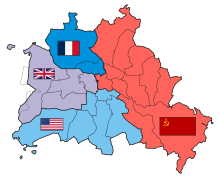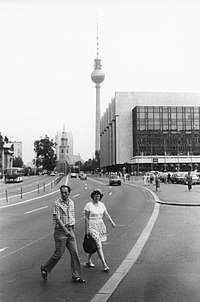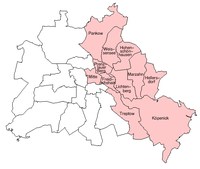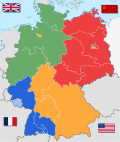East Berlin: Difference between revisions
m fix |
m Interwiki UR |
||
| Line 173: | Line 173: | ||
[[sv:Östberlin]] |
[[sv:Östberlin]] |
||
[[th:เบอร์ลินตะวันออก]] |
[[th:เบอร์ลินตะวันออก]] |
||
[[ur:مشرقی برلن]] |
|||
[[vi:Đông Berlin]] |
[[vi:Đông Berlin]] |
||
[[zh:东柏林]] |
[[zh:东柏林]] |
||
Revision as of 03:24, 28 August 2009
| East Berlin Ostberlin or Berlin (Ost) | |||||||||
|---|---|---|---|---|---|---|---|---|---|
| Soviet-occupied sector of Berlin, East Germany | |||||||||
| 1949–1990 | |||||||||
|
Flag | |||||||||
 The four occupation zones of Berlin. East Berlin is in red | |||||||||
| Area | |||||||||
• 1989 | 409 km2 (158 sq mi) | ||||||||
| Population | |||||||||
• 1989 | 1,279,212 | ||||||||
| Historical era | Cold War | ||||||||
• Established | 1949 | ||||||||
| 3 October 1990 | |||||||||
| |||||||||
East Berlin was the name given to the eastern part of Berlin between 1949 and 1990. It consisted of the Soviet sector of Berlin that was established in 1945. The American, British and French sectors became West Berlin, a de facto part of West Germany. Despite its status as part of an occupied city, East Berlin was claimed as the capital of East Germany. From 13 August 1961 until 9 November 1989 East Berlin was separated from West Berlin by the Berlin Wall. The East German government referred to East Berlin simply as "Berlin" or often "Berlin, Hauptstadt der DDR" (Berlin, capital of the GDR). The term "Democratic Sector" was also used until the 1960s. (See also Naming conventions)
The Western Allies (the USA, Britain and France) never formally acknowledged the authority of the East German government to govern East Berlin; the official Allied protocol recognized only the authority of the Soviet Union in East Berlin in accordance with the occupation status of Berlin as a whole. The United States Command Berlin, for example, published detailed instructions for U.S. military and civilian personnel wishing to visit East Berlin.[1] In fact, the three Western commandants regularly protested the presence of the East German National People's Army (NVA) in East Berlin, particularly on the occasion of military parades. Nevertheless, the three Western Allies eventually established embassies in East Berlin in the 1970s, although they never recognized it as the capital of East Germany. Treaties instead used terms such as "seat of government."
On 3 October 1990, West and East Germany were reunited, thus formally ending the existence of East Berlin.
East Berlin today
Since reunification, the German government has spent vast amounts of money on reintegrating the two halves of the city and bringing services and infrastructure in the former East Berlin up to the standard established in West Berlin. Despite this, there are still obvious differences between eastern and western Berlin. Eastern Berlin has a distinctly different visual aspect, partly because of the greater survival of prewar façades and streetscapes, some still showing signs of wartime damage, and partly because of the distinctive style of urban Stalinist architecture used in the GDR. As in other former East German cities, a small number of GDR-era names commemorating socialist heroes have been preserved, such as Karl-Marx-Allee, Rosa-Luxemburg-Platz and Karl-Liebknecht-Straße; this followed a long process of review in which many such street names were deemed inappropriate and were changed. Still visible throughout former East Berlin are the characteristic "Ampelmännchen" on some pedestrian traffic lights. These days they are also visible in parts of the former West Berlin following a civic debate about whether the "Ampelmännchen" should be abolished or disseminated more widely.
Soviet and East German Commandants of East Berlin

| Name [2] | Term |
|---|---|
| Nikolay Berzarin | 2 May 1945 - 16 June 1945 |
| Aleksandr Gorbetov | 17 June 1945 - 19 November 1945 |
| Dimitry Smirnov | 19 November 1945 - 1 April 1946 |
| Aleksandr Kotikov | 1 April 1946 - 7 June 1950 |
| Sergey Dienghin | 7 June 1950 - April 1953 |
| Pavel Dibrova | April 1953 - 23 June 1956 |
| Andrey Chamov | 28 June 1956 - 26 February 1958 |
| Nikolay Zakharov | 26 February 1958 - 9 May 1961 |
| Andrey Soloviev | 9 May 1961 - 22 August 1962 |
| Helmut Poppe | 22 August 1962 - 31 May 1971 |
| Artur Kunath | 1 June 1971 - 31 August 1978 |
| Karl-Heinz Drews | 1 September 1978 - 31 December 1988 |
| Wolfgang Dombrowski | 1 January 1989 - 30 September 1990 |
| Detlef Wendorf | 1 October 1990 - 2 October 1990 |
Boroughs of East Berlin

At the time of German reunification, East Berlin comprised the boroughs of
- Friedrichshain
- Hellersdorf (since 1986)
- Hohenschönhausen (since 1985)
- Köpenick
- Lichtenberg
- Marzahn (since 1979)
- Mitte
- Pankow
- Prenzlauer Berg
- Treptow
- Weißensee
Images of East Berlin
-
Karl Marx Allee apartments
-
Wall plaque of Lenin, off Wilhelmstraße
-
GDR-era mural of Meissen porcelain on former Council of Ministers building, facing Leipziger Straße
-
The Soviet War Memorial in Treptower Park
-
Cafe Moskau in Karl Marx Allee
-
The Palace of the Republic, being dismantled
-
"Hochhaus" in Weberwiese- the first high rise apartment that was built after the war
-
People's Theatre, Rosa-Luxemburg-Platz
-
Late-1980s GDR apartment blocks on the Wilhelmstraße
-
Strausberger Platz with constructivism style building
-
Proletarian hero, Alexanderplatz
-
Statues of Marx and Engels, Marx-Engels-Forum
See also
- History of Berlin
- Berlin Wall
- Bonn
- Cold War
- Checkpoint Charlie
- East Germany
- Ghost station
- History of Germany since 1945
- West Berlin
References
- ^ "Helpful Hints for US Visitors to East Berlin" (PDF). Headquarters, U.S. Command Berlin. 1981-11-09.
{{cite journal}}: Cite journal requires|journal=(help) - ^ "Commandants of Berlin Soviet Zone". World Statesmen.org.









